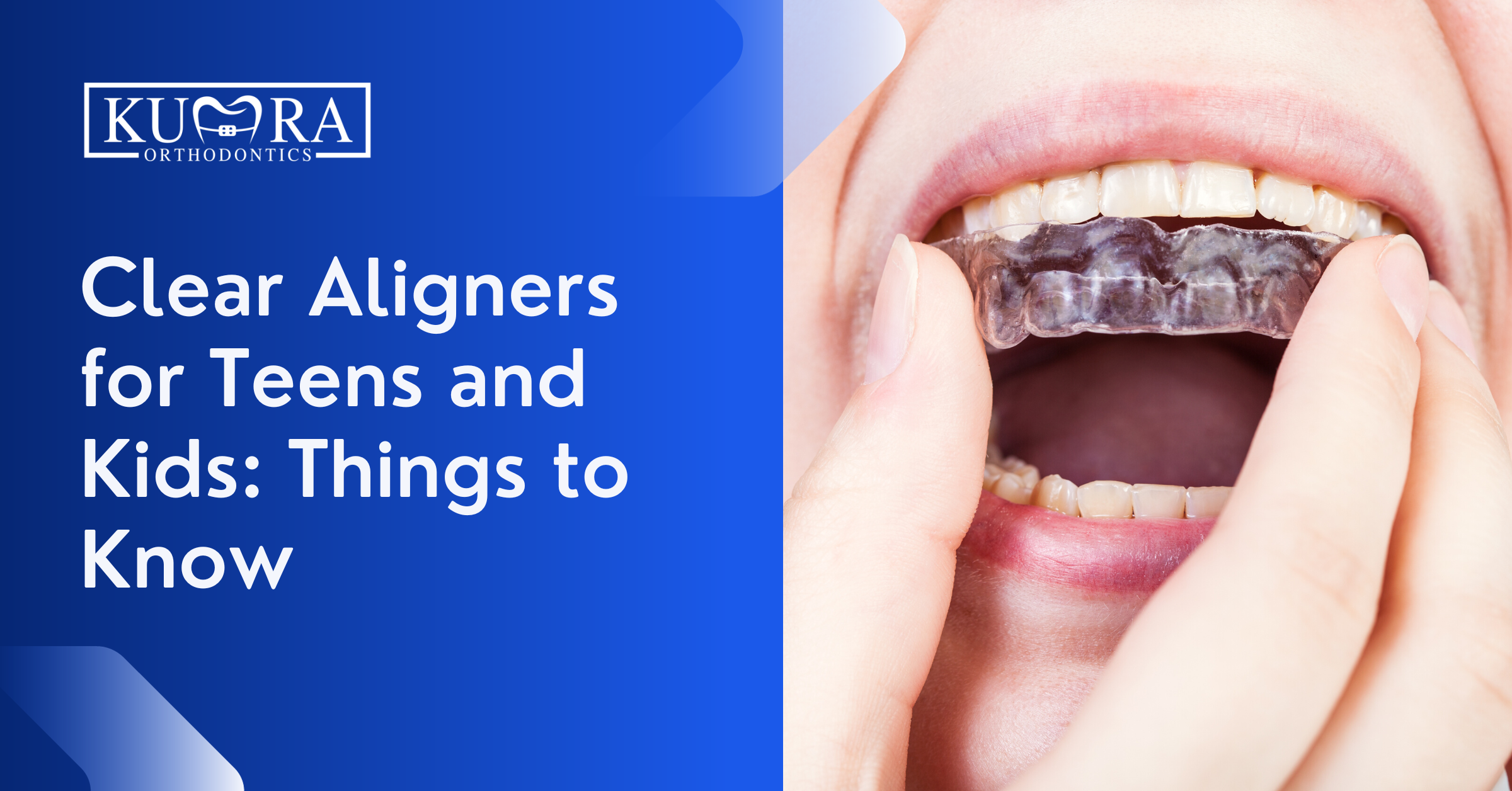Navigating the world of orthodontics for your child can be overwhelming, especially with the various options available today. As the demand for less noticeable teeth-straightening solutions grows, Invisalign for teens has emerged as a popular choice among parents and youngsters alike.
In this blog post, we’ll delve into the world of clear aligners for both teens and kids, shedding light on what you need to know before taking the plunge. Whether you’re considering Invisalign or other clear aligner brands, this guide will offer insights and tips to help you make an informed decision.
The Importance of Teen Orthodontics
The teenage years are a crucial period in dental development. As permanent teeth settle into their positions and facial structures continue to grow, addressing any misalignments or abnormalities becomes essential. Furthermore, orthodontics not only plays a vital role in ensuring proper bite and alignment, but it also greatly influences self-confidence and self-esteem. With straight teeth and a balanced bite, teens can speak, eat, and smile with confidence, reducing the likelihood of dental issues in the future. Moreover, timely orthodontic intervention can prevent more complex and prolonged treatments in adulthood. Thus, investing in teen orthodontics is not merely about aesthetics; it’s about setting the foundation for a lifetime of oral health and well-being.
Read More: A Parent’s Complete Guide to Invisalign for Teens
What Are Clear Aligners?
Clear aligners are a modern solution to orthodontic treatment that offers an alternative to traditional braces. Made of transparent, medical-grade plastic, these aligners are custom-molded to fit snugly over the teeth, providing gentle pressure to gradually shift them into the desired position. Unlike metal brackets and wires, clear aligners are nearly invisible, making them a discreet option for those conscious about their appearance. They are also removable, allowing users to eat, drink, and maintain their oral hygiene routines without obstruction.
Each set of aligners is worn for a specific period, typically one to two weeks, before transitioning to the next set in the series, steadily moving the teeth to their ideal alignment. Their blend of functionality and aesthetics has made clear aligners a preferred choice for many seeking a more convenient and less noticeable orthodontic solution.
Clear Aligners Pros
Clear aligners bring a host of advantages to the table, blending modern technology with patient comfort and convenience. Here are some of its advantages:
Aesthetically Pleasing
One of the most prominent benefits of clear aligners is their near-invisibility. They offer a discreet way to straighten teeth without the noticeable appearance of metal brackets and wires, making them especially popular among adults and teens who might be self-conscious about traditional braces.
Removable Design
Unlike traditional braces, clear aligners can be taken out for eating, drinking, brushing, and flossing. This means fewer food restrictions and easier oral hygiene maintenance. They also reduce the likelihood of post-treatment discoloration or decay that can sometimes occur with traditional braces.
Comfort
Without metal brackets to irritate the cheeks and gums, many users find clear aligners more comfortable. The smooth plastic design minimizes discomfort and abrasion. They are also safer for active teenagers, specifically those involved in sports or other physical activities.
Predictable Treatment
Using advanced 3D imaging, orthodontists can plan the entire treatment process from start to finish. Patients can even see a digital representation of how their teeth will move over time, providing a clear picture of the expected results.
Fewer Office Visits
Unlike traditional braces which require regular tightening, clear aligners generally require fewer trips to the orthodontist. This can save time, especially for busy individuals.
Clear Aligners Cons
While clear aligners have many attractive benefits, it also comes with several disadvantages. Below are some examples:
Limited Treatment Scope
One of the primary limitations of clear aligners is their scope of treatment. While they are exceptionally adept at correcting mild to moderate dental misalignments, their effectiveness wanes when faced with more complex orthodontic challenges. Severe overbites, pronounced underbites, or intricate rotations often necessitate the structural strength and precision that traditional braces offer.
Requires Discipline
The design advantage of clear aligners, being removable, can also be their Achilles heel. To achieve the desired results within the projected timeline, users must exhibit a high degree of discipline, wearing their aligners for the recommended 20-22 hours daily. Unlike fixed braces, which work round the clock irrespective of the wearer’s habits, the efficacy of clear aligners is directly proportional to the commitment of the user.
Potential for Loss
The removability of clear aligners makes them prone to being misplaced or lost. Whether left on a lunch tray, wrapped in a napkin, or simply forgotten on a nightstand, the loss of an aligner can be a costly and inconvenient hiccup in the treatment process.
Price
Financial considerations are often paramount when selecting orthodontic treatments. Depending on the specific requirements of the patient and their geographic location, the cost of clear aligners can sometimes become more expensive than traditional braces, especially when insurance doesn’t cover them.
Refinement Period
Orthodontic perfection often demands finetuning. After the primary phase of aligner therapy, some patients discover they need additional aligners, or refinements, to achieve their dream results. This secondary phase can extend the overall treatment duration, potentially leading to added costs and commitments.
Needing an orthodontic appointment?
Visit Kumra Orthodontics Washington, DC or Kumra Orthodontics Stafford, VA, and request an appointment with us!
Different Types of Clear Aligners
clear aligners have carved out a significant niche, offering patients a discreet and often more comfortable alternative to traditional braces. As their popularity has grown, so too has the number of brands and types available. Here’s a look at some of the most notable clear aligner options on the market:
Invisalign
Often regarded as the pioneer in the clear aligner industry, Invisalign has treated millions of patients worldwide. Their aligners are custom-made using a proprietary SmartTrack material, ensuring a snug fit. The treatment involves a series of aligners, each worn for about two weeks, gradually moving teeth to their desired position.
SmileDirectClub
Adopting a direct-to-consumer approach, SmileDirectClub allows patients to get clear aligners without frequent visits to an orthodontist. After an initial assessment, either via a home impression kit or a visit to one of their SmileShops, patients receive a series of aligners to wear over the treatment period.
Byte
Another direct-to-consumer brand, Byte stands out with its proprietary HyperByte technology—a device that uses gentle vibrations to decrease treatment time and discomfort. Byte offers both daytime and nighttime wear options, catering to users’ preferences and lifestyles.
3M Clarity Aligners
From the renowned brand 3M, these aligners offer a clear, comfortable, and customizable solution for teeth straightening. Their digital treatment planning tools and integration with other 3M orthodontic products make them a favorite among many dental professionals.
Retain
Focusing on minimal design and maximum comfort, Retain offers ultra-thin aligners. They emphasize precision and employ advanced 3D imaging techniques to ensure effective and predictable treatment outcomes.
ClearCorrect
ClearCorrect is a notable brand in the clear aligner industry. It offers BPA-free plastic aligners that are virtually invisible, presenting a cosmetic alternative to traditional braces. As with other aligners, the treatment involves wearing a series of custom-made trays that gradually shift teeth into their desired positions.
Related: ClearCorrect vs. Invisalign: Which Is Better?
Clear Aligners for Teens and Kids: Exploring Options
As parents and guardians, we naturally seek the best for our young ones, especially when it comes to health and aesthetics. In this section, we’ll delve into the world of clear aligners for teens and kids, exploring the available options and understanding their unique benefits.
Invisalign Teen
Invisalign Teen was introduced to address the unique orthodontic challenges faced by adolescents. One such innovation is the wear-indicator, a colored dot on the aligners that fades over time, giving both orthodontists and parents a visual gauge of how consistently the aligners are being worn. Additionally, considering the dynamic dental landscape of teens, where new molars might still be emerging or baby teeth might be on their way out, Invisalign Teen aligners are crafted with these changes in mind.
SureSmile
One of the standout features of SureSmile is its ability to offer shorter treatment durations in comparison to some other methods. For kids and teens, this can mean less time spent in orthodontic treatment and quicker results. The aligners are not just clear but are also designed with comfort in mind, making them an appealing choice for the younger generation who are often first-time orthodontic patients.
3M Clarity Aligners for Kids
3M, a giant in the dental and orthodontic sphere, brings its vast expertise to the table with the Clarity Aligners tailored specifically for children. Recognizing that children’s teeth and jaws are in a constant state of growth and evolution, these aligners are crafted to accommodate and complement these changes. The blend of top-notch technology ensures the aligners are not just effective but also comfortable for younger wearers. 3M Clarity Aligners are also designed for a snug fit, ensuring minimal speech disruption, which can be a concern for many kids and parents alike.
How Long Do Clear Aligners Take?
The duration of treatment with clear aligners varies widely based on individual dental needs. Typically, for mild to moderate misalignments, patients can anticipate a timeline ranging from 6 to 18 months. However, this is a generalized estimate.
Factors such as the complexity of the orthodontic issue, patient compliance in wearing the aligners for the recommended 20-22 hours per day, and the specific brand of aligner chosen can influence the treatment duration.
It’s imperative to consult with an expert orthodontist to get a tailored estimate, ensuring you embark on your clear aligner journey with clear expectations in mind.
Clear Aligners vs Clear Braces for Teens: Is There a Difference?
At first glance, both offer an aesthetically pleasing solution, but they’re distinct in their mechanisms and functionalities. Clear aligners, like Invisalign Teen, are removable trays made of a transparent plastic material that gradually shift teeth into correct positions. They offer flexibility, allowing teens to remove them for activities, eating, or special events.
On the other hand, clear braces, often made of ceramic or porcelain, function much like traditional metal braces. They are affixed to the teeth with brackets and wires, but their translucent nature makes them less noticeable. While clear braces remain on the teeth throughout the treatment, they offer precision in addressing more complex orthodontic issues.
Read More: Is Invisalign Cheaper Than Regular Braces?
Clear Aligners for Teens FAQs
What is the best age to get clear aligners?
While there isn’t a strict best age to start using clear aligners, they are generally recommended for older teens and adults. This is primarily because by this stage, most of the permanent teeth have erupted, and the jaw has developed sufficiently, making the treatment more predictable.
Who should not get clear aligners?
Individuals with severe malocclusion, extensive spacing, or other complex dental issues might find traditional braces more effective. Clear aligners are best suited for mild to moderate orthodontic corrections. Moreover, the success of clear aligners hinges on the wearer’s commitment, as they need to be worn consistently for 20-22 hours a day. Those unable or unwilling to adhere to this regimen might not achieve the desired results.
How often should you brush your teeth with clear aligners?
It’s recommended that users brush their teeth every time they eat or drink anything other than water. This ensures that no food particles or residue are trapped between the aligners and the teeth, which could lead to staining or cavities. Essentially, maintaining a regimen of brushing and flossing at least three times a day, or after each meal, helps in preserving both the integrity of the aligners and the health of the teeth.
Unlock Your Child’s Best Smile with Kumra Orthodontics!
clear aligners have emerged as a game-changer, especially for teens and kids seeking both aesthetics and effective treatment. These state-of-the-art devices blend discretion, functionality, and convenience, making them a highly sought-after choice for the modern generation. But, as with all dental treatments, the journey is as significant as the destination. It’s not just about choosing the right treatment, but also the right hands to guide you through it.
At Kumra Orthodontics, we pride ourselves on our expertise, dedication, and patient-first approach. If you or your young one is contemplating a journey towards a radiant, perfectly-aligned smile, reach out to us. Let Kumra Orthodontics be the trusted partner in unveiling that transformative smile that lasts a lifetime.



